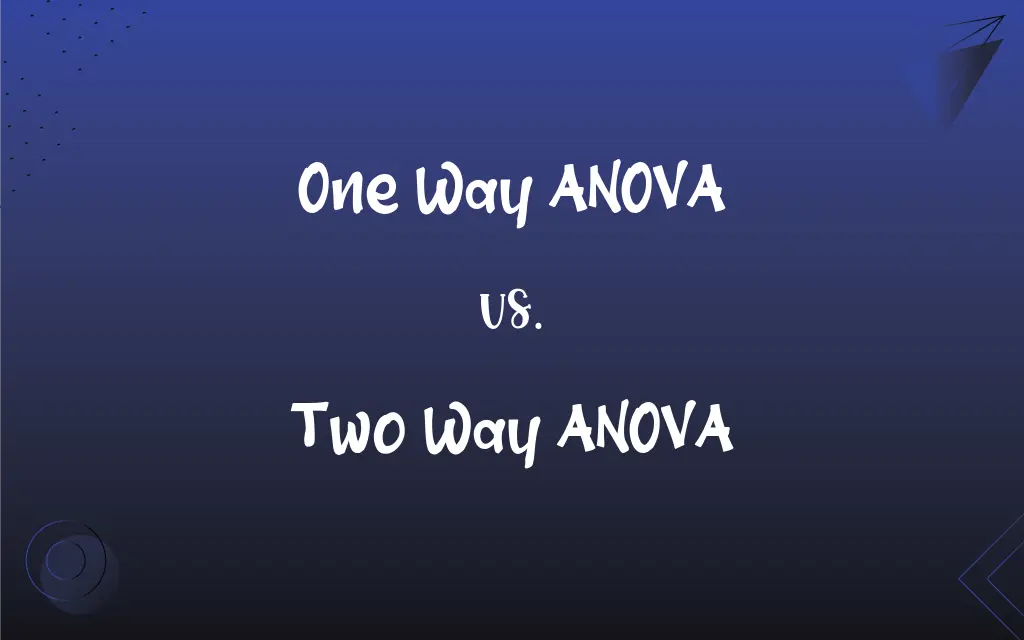One Way ANOVA vs. Two Way ANOVA: What's the Difference?
Edited by Aimie Carlson || By Janet White || Published on February 23, 2024
One Way ANOVA analyzes variance between groups based on one factor; Two Way ANOVA does so for two factors, also exploring the interaction between them.

Key Differences
One Way ANOVA is a statistical method used to compare means across multiple groups based on a single independent variable. It identifies whether at least one group mean is statistically different from others. Conversely, Two Way ANOVA extends this analysis by considering two independent variables. It not only compares group means across these two factors but also investigates the interaction between them.
In One Way ANOVA, the focus is on understanding how a single factor affects a dependent variable. For example, it might analyze how different teaching methods (single factor) affect students' test scores. Two Way ANOVA, however, looks at two factors simultaneously. For instance, it could assess how teaching methods and class sizes jointly impact test scores, including the interaction between teaching method and class size.
The simplicity of One Way ANOVA makes it suitable for situations with a straightforward experimental design involving just one categorical independent variable. On the other hand, Two Way ANOVA is more complex and applicable in designs where the effects of two categorical independent variables, and their interaction, on a continuous outcome need to be understood.
One Way ANOVA provides a singular main effect – the effect of the single independent variable on the dependent variable. In contrast, Two Way ANOVA offers three main effects: the individual effects of each of the two independent variables and their interaction effect. This allows for a more comprehensive understanding of the relationships in the data.
When using One Way ANOVA, assumptions such as homogeneity of variances and normality must be met for a single factor. Two Way ANOVA requires these assumptions to be met for two factors and also assumes no significant interaction if the interaction effect is not of primary interest. This adds a layer of complexity in the analysis and interpretation of results.
ADVERTISEMENT
Comparison Chart
Number of Factors
Analyzes one independent variable.
Analyzes two independent variables.
Main Effects
Provides the effect of one factor on the dependent variable.
Provides effects of two factors, including their interaction.
Complexity
Simpler, suitable for single-factor analysis.
More complex, suitable for multi-factor analysis.
Interaction Effects
Does not consider interaction effects.
Examines interaction effects between the two factors.
Suitability
Ideal for straightforward, single-variable experimental designs.
Better for complex designs where multiple variables interact.
ADVERTISEMENT
One Way ANOVA and Two Way ANOVA Definitions
One Way ANOVA
One Way ANOVA is a statistical test for comparing the means of three or more independent groups using one factor.
Using One Way ANOVA, researchers determined if different diets had significantly different effects on weight loss.
Two Way ANOVA
Two Way ANOVA is used to understand how two categorical independent variables and their interaction influence a continuous outcome.
A Two Way ANOVA was conducted to determine how gender and age groups differently perceive a brand.
One Way ANOVA
One Way ANOVA is used to compare means of groups in an experiment with one categorical independent variable.
The company used One Way ANOVA to compare customer satisfaction levels across four store locations.
Two Way ANOVA
Two Way ANOVA allows comparison of group means across two factors, considering their potential interaction.
The study used Two Way ANOVA to analyze how teaching method and class size independently and jointly affected test scores.
One Way ANOVA
One Way ANOVA determines whether means of groups are equal across a single factor in an experimental setting.
One Way ANOVA was applied to assess if different training methods affected employee productivity uniformly.
Two Way ANOVA
Two Way ANOVA is a statistical method for analyzing the effects of two independent variables on a dependent variable.
Researchers used Two Way ANOVA to examine how temperature and humidity jointly affected mold growth.
One Way ANOVA
One Way ANOVA is a technique to test if there is a significant effect of a single independent variable on a continuous dependent variable.
A One Way ANOVA revealed that plant growth rates varied significantly under different light conditions.
Two Way ANOVA
Two Way ANOVA assesses the main effects of two variables and their combined effect on a dependent variable.
Using Two Way ANOVA, scientists evaluated the influence of light and fertilizer type on plant growth.
One Way ANOVA
One Way ANOVA analyzes the variance among group means to infer if at least one group differs significantly.
The One Way ANOVA showed significant differences in student performance across three teaching methods.
Two Way ANOVA
Two Way ANOVA tests for both individual and interaction effects of two factors on a response variable.
Two Way ANOVA revealed not only the effect of diet and exercise on weight loss but also their interaction.
FAQs
When is Two Way ANOVA applicable?
It's suitable when analyzing the influence of two independent variables and their interaction on an outcome.
What is One Way ANOVA?
It's a statistical method to compare means of three or more groups based on one factor.
When should I use One Way ANOVA?
Use it when comparing multiple groups based on a single categorical independent variable.
Can I use One Way ANOVA for two factors?
No, One Way ANOVA is limited to one independent variable.
What assumptions does Two Way ANOVA require?
Similar to One Way ANOVA, plus no significant interactions if not of primary interest.
What is Two Way ANOVA?
It analyzes the effects of two factors on a dependent variable, including their interaction.
Does One Way ANOVA account for interaction effects?
No, it only assesses the effect of one factor without considering interactions.
Can Two Way ANOVA assess interaction between factors?
Yes, it evaluates both individual and interaction effects of two factors.
What types of variables are used in Two Way ANOVA?
Two categorical independent variables and one continuous dependent variable.
What are the assumptions of One Way ANOVA?
Assumptions include normal distribution, homogeneity of variances, and independent observations.
Is Two Way ANOVA more complex than One Way ANOVA?
Yes, due to the additional factor and potential interactions.
What are the main effects in Two Way ANOVA?
The individual effects of each factor and their interaction effect.
What happens if assumptions are violated in One Way ANOVA?
Results may be inaccurate; alternative methods or data transformation might be needed.
How does One Way ANOVA handle multiple comparisons?
Post-hoc tests are used to control for multiple comparisons.
Does Two Way ANOVA require balanced data?
It's preferable, but unbalanced designs can be analyzed with certain adjustments.
What kind of data is suitable for One Way ANOVA?
Data with a continuous dependent variable and a single categorical independent variable.
How do I interpret the results of a One Way ANOVA?
Look at the significance of the F-test to determine if there's a difference among group means.
Can I use Two Way ANOVA for more than two factors?
No, for more than two factors, you would use a factorial ANOVA or a different method.
How are interactions interpreted in Two Way ANOVA?
By examining if the combined effect of two variables significantly affects the dependent variable.
Can One Way ANOVA determine which groups differ?
It indicates if there's a difference but not which groups differ; post-hoc tests are needed for that.
About Author
Written by
Janet WhiteJanet White has been an esteemed writer and blogger for Difference Wiki. Holding a Master's degree in Science and Medical Journalism from the prestigious Boston University, she has consistently demonstrated her expertise and passion for her field. When she's not immersed in her work, Janet relishes her time exercising, delving into a good book, and cherishing moments with friends and family.
Edited by
Aimie CarlsonAimie Carlson, holding a master's degree in English literature, is a fervent English language enthusiast. She lends her writing talents to Difference Wiki, a prominent website that specializes in comparisons, offering readers insightful analyses that both captivate and inform.







































































